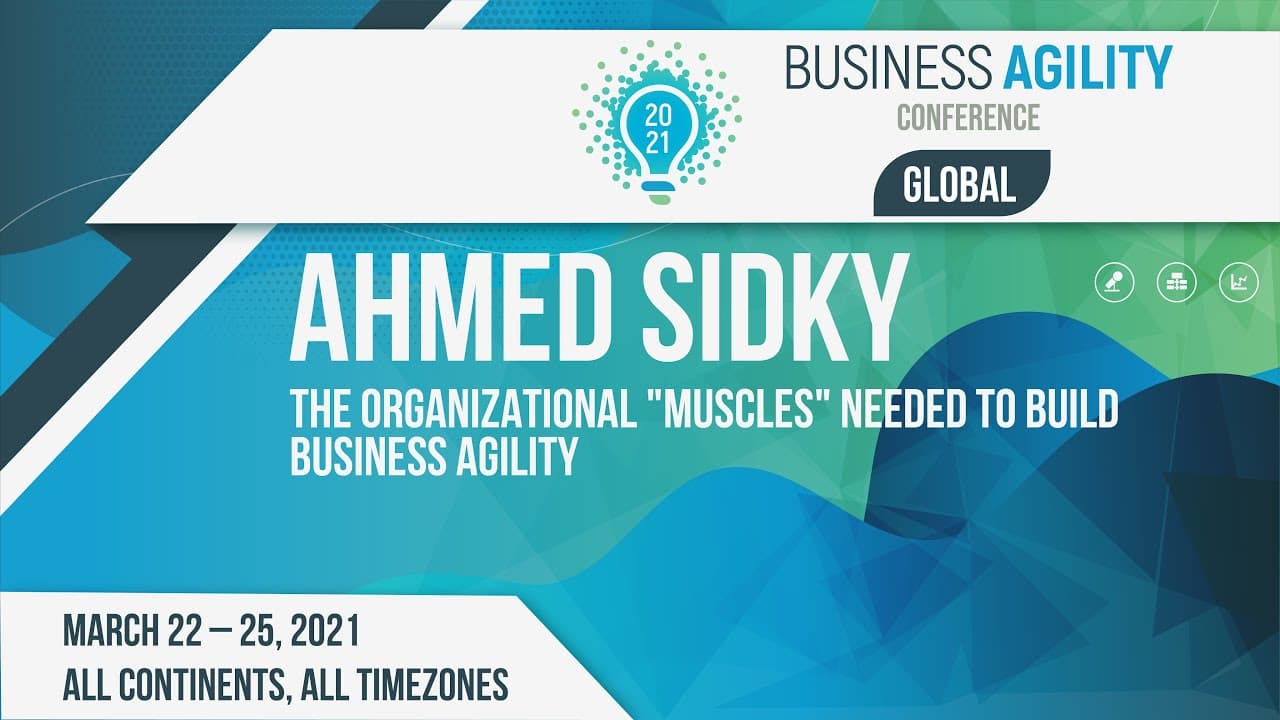Welcome, everyone! It’s a pleasure to be here, and I appreciate you all joining. Let’s dive right in. Today, we’re going to talk about the organizational muscles needed to build business agility. We’ll explore these muscles and, hopefully, I’ll have time to share a real-life story that demonstrates how they work in action.
Agility as an Athletic Metaphor
I want to start by drawing an analogy from the world of sports. Sports provide a great metaphor for business agility because agility isn’t something you either have or don’t have—it’s something you develop over time. If you stop practicing, you lose it, just like fitness or athletic ability.
Anyone can develop agility, but it requires effort. It’s a hard, long journey, but it’s accessible to everyone. This applies to organizations, too. I often hear companies say, "That company was born agile, but we’re too big." The truth is, every organization can increase its agility, just like an athlete training for a sport. However, the muscles you focus on depend on your goals. If you need upper-body strength, you train those muscles. If you need lower-body strength, you work on your quads and hamstrings.
With that metaphor in mind, I want to introduce an organizational perspective: the Domains of Business Agility by the Business Agility Institute. Think of these as the muscles of your organization. There are three muscle groups surrounding a core muscle group at the center. Today, I’ll quickly go over these groups and then share a story illustrating how they work together.
The Core Muscle: Customer Centricity
The core muscle group is the foundation of business agility—alignment around a shared purpose of customer centricity. This is critical because business agility isn’t just about optimization or efficiency; it’s about serving the customer. Without this sense of purpose, the transformation required for true agility becomes too difficult.
For example, at Riot Games, our mission from day one has been: "We aspire to be the most player-focused game company in the world." This mindset drives every decision we make. We have an equation: Player > Riot > Team > Me, meaning that when trade-offs need to be made, we prioritize what’s best for the player. This customer-first mindset is at the heart of business agility.
The Supporting Muscles: Board, Workforce, and Partners
Surrounding the core are three key muscle groups:
- Workforce: You can’t be customer-centric if you don’t hire people who are passionate about your mission.
- Board: Your board must support long-term bets in service of the customer, rather than demanding short-term gains.
- Partners: Most organizations rely on partners, and if those partners are transactional rather than customer-centric, the customer will feel it.
If these three elements aren’t aligned with customer centricity, achieving business agility will be difficult.
The Leadership Muscle Group
Leadership plays a crucial role in fostering agility. Key leadership muscles include:
- People Leadership: Hiring, developing, and empowering people for their potential, not just their current role.
- One Team Mindset: Moving away from siloed thinking and working toward shared goals across divisions.
- Strategic Agility: Setting strategy in a way that creates space for teams to learn, experiment, and innovate.
The Operations Muscle Group
Operational agility includes:
- Process Agility: Continuously improving workflows and adapting operations.
- Structural Agility: The ability to create teams and coalitions fluidly, without massive reorgs.
- Enterprise Agility: Ensuring HR, finance, legal, and other functions enable agility rather than stifle it.
The Individual Muscle Group
Agility also depends on individuals within the organization. Key muscles here include:
- Ownership and Accountability: Employees must feel a sense of responsibility and be empowered to act.
- Craft Excellence: Investing in the key skills that create the most value for customers.
- Growth Mindset: Fostering a culture of learning, experimentation, and adaptability.
Bringing It All Together: The Riot Games Story
Business agility is a set of organizational capabilities, behaviors, and ways of working that provide the freedom, flexibility, and resilience to achieve your purpose—no matter what the future brings. Let’s look at a real-world example from Riot Games.
In 2018, we were preparing for the League of Legends World Championships in Korea. One of our music producers had a bold idea: What if we created a virtual pop band using augmented reality, featuring characters from our game? The band would perform on stage, and we would simultaneously release a hit single and a music video. The idea was exciting, but there was a problem—none of it was planned or budgeted.
However, we had spent years cultivating the muscles necessary to make this happen:
- Learning and Experimentation: We had built a culture that encouraged new ideas.
- Craft Excellence: We had developed expertise in music videos, album production, and artist collaborations.
- One Team Mindset: We overcame silos and worked across departments to bring the idea to life.
- Structural Agility: We formed a cross-functional team quickly.
- Enterprise Agility: Our finance and legal teams adapted fast, signing 25 contracts in weeks.
The result? We successfully launched K/DA, a virtual K-pop band, with a performance that stunned our audience. It became a massive hit, demonstrating how agility in strategy, leadership, operations, and individuals can turn bold ideas into reality.
Final Thoughts
We started with the Domains of Business Agility, comparing them to organizational muscles. But these muscles don’t work in isolation. They come together to build key capabilities that enable freedom, flexibility, and resilience—ensuring organizations can achieve their purpose, no matter what the future brings.
Thank you for joining today. I hope this discussion gave you a new perspective on how to develop business agility within your organization!



